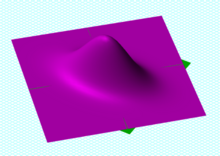A | B | C | D | E | F | G | H | CH | I | J | K | L | M | N | O | P | Q | R | S | T | U | V | W | X | Y | Z | 0 | 1 | 2 | 3 | 4 | 5 | 6 | 7 | 8 | 9
| Part of a series on Statistics |
| Correlation and covariance |
|---|


In probability theory and statistics, a covariance matrix (also known as auto-covariance matrix, dispersion matrix, variance matrix, or variance–covariance matrix) is a square matrix giving the covariance between each pair of elements of a given random vector.
Intuitively, the covariance matrix generalizes the notion of variance to multiple dimensions. As an example, the variation in a collection of random points in two-dimensional space cannot be characterized fully by a single number, nor would the variances in the and directions contain all of the necessary information; a matrix would be necessary to fully characterize the two-dimensional variation.
Any covariance matrix is symmetric and positive semi-definite and its main diagonal contains variances (i.e., the covariance of each element with itself).
The covariance matrix of a random vector is typically denoted by , or .
Definition
Throughout this article, boldfaced unsubscripted and are used to refer to random vectors, and Roman subscripted and are used to refer to scalar random variables.
If the entries in the column vector
are random variables, each with finite variance and expected value, then the covariance matrix is the matrix whose entry is the covariance[1]: p. 177
where the operator denotes the expected value (mean) of its argument.
Conflicting nomenclatures and notationsedit
Nomenclatures differ. Some statisticians, following the probabilist William Feller in his two-volume book An Introduction to Probability Theory and Its Applications,[2] call the matrix the variance of the random vector , because it is the natural generalization to higher dimensions of the 1-dimensional variance. Others call it the covariance matrix, because it is the matrix of covariances between the scalar components of the vector .
Both forms are quite standard, and there is no ambiguity between them. The matrix is also often called the variance-covariance matrix, since the diagonal terms are in fact variances.
By comparison, the notation for the cross-covariance matrix between two vectors is
Propertiesedit
Relation to the autocorrelation matrixedit
The auto-covariance matrix is related to the autocorrelation matrix
Text je dostupný za podmienok Creative
Commons Attribution/Share-Alike License 3.0 Unported; prípadne za ďalších
podmienok.
Podrobnejšie informácie nájdete na stránke Podmienky
použitia.


















